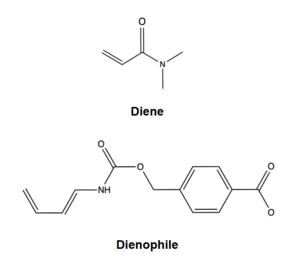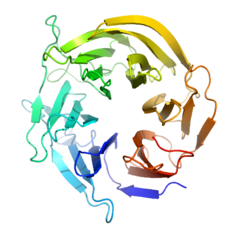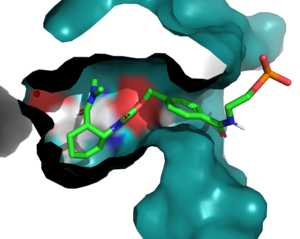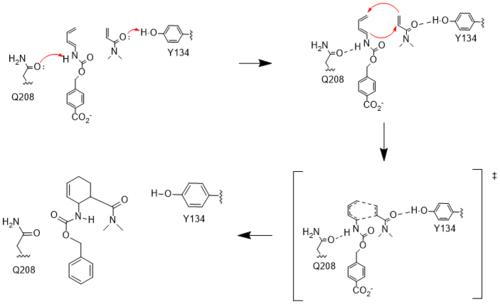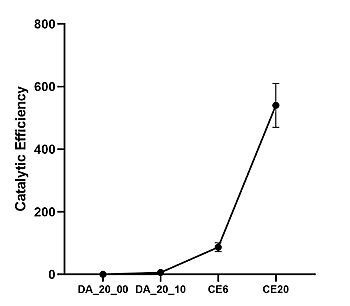Sandbox Reserved 1852
From Proteopedia
(Difference between revisions)
| Line 5: | Line 5: | ||
==Introduction== | ==Introduction== | ||
[[Image:DielsAlderasesubstrates.png|300px|left|thumb|Figure 1. Diels-Alderase substrates]] | [[Image:DielsAlderasesubstrates.png|300px|left|thumb|Figure 1. Diels-Alderase substrates]] | ||
| - | The Diels-Alderase protein aims to create optimal reacting conditions between the diene and dienophile in a [https://en.wikipedia.org/wiki/Diels%E2%80%93Alder_reaction Diels-Alder reaction.] It accomplishes this by decreasing the energy gap between the dienophile’s lowest unoccupied molecular orbital [https://en.wikipedia.org/wiki/HOMO_and_LUMO (LUMO)]and the diene’s highest occupied molecular orbital [https://en.wikipedia.org/wiki/HOMO_and_LUMO (HOMO)]in the transition state.<ref name="Siegel">PMID:20647463</ref> The binding pocket of 4O5T is selective for two substrates, 4-carboxybenzyl trans-1,3-butadiene-1-carbamate (diene) and N,N- dimethylacrylamide (dienophile). The binding site contains | + | The Diels-Alderase protein aims to create optimal reacting conditions between the diene and dienophile in a [https://en.wikipedia.org/wiki/Diels%E2%80%93Alder_reaction Diels-Alder reaction.] It accomplishes this by decreasing the energy gap between the dienophile’s lowest unoccupied molecular orbital [https://en.wikipedia.org/wiki/HOMO_and_LUMO (LUMO)]and the diene’s highest occupied molecular orbital [https://en.wikipedia.org/wiki/HOMO_and_LUMO (HOMO)]in the transition state.<ref name="Siegel">PMID:20647463</ref> The binding pocket of 4O5T is selective for two substrates, 4-carboxybenzyl trans-1,3-butadiene-1-carbamate ([https://en.wikipedia.org/wiki/Diene diene]) and N,N- dimethylacrylamide (dienophile). The binding site contains a [https://en.wikipedia.org/wiki/Hydrogen_bond hydrogen bond] donor (Y134) which lowers the LUMO energy and stabilizes the negative charge on the dienophile and a hydrogen bond acceptor (Q208) that increases the HOMO energy and stabilizes the positive charge on the diene.<ref name="Siegel"/> Both of these H-bonding interactions work to stabilize the transition state, while also orienting the substrates in optimal conformations for reacting. |
The Diels-Alderase enzyme was built using de novo enzyme design, which relies on computational modeling that is refined through programming and collaborative problem-solving from online users. The original protein was made using the [https://en.wikipedia.org/wiki/Rosetta@home Rosetta] computational design program, where a potential active site was built and tested against a library of scaffold proteins. Later, as the active site was perfected, future generations of the Diels-Alderase were made using an online protein folding game called [https://en.wikipedia.org/wiki/Foldit Foldit,] where players competed to improve binding efficiency by completing various challenges.<ref name="Eiben"/> | The Diels-Alderase enzyme was built using de novo enzyme design, which relies on computational modeling that is refined through programming and collaborative problem-solving from online users. The original protein was made using the [https://en.wikipedia.org/wiki/Rosetta@home Rosetta] computational design program, where a potential active site was built and tested against a library of scaffold proteins. Later, as the active site was perfected, future generations of the Diels-Alderase were made using an online protein folding game called [https://en.wikipedia.org/wiki/Foldit Foldit,] where players competed to improve binding efficiency by completing various challenges.<ref name="Eiben"/> | ||
| Line 19: | Line 19: | ||
In the active state, there are <scene name='10/1075254/Active_site/3'>two catalytic residues</scene> that aim to stabilize the transition state of the Diels-Alder reaction. The Y134 acts as a <scene name='10/1075253/Y134_h_donation/1'>hydrogen bond donor</scene> to the oxygen on the <scene name='10/1075253/Ligand/6'>ligand</scene>. Q208 acts as a <scene name='10/1075253/208_bond_donor/1'>hydrogen bond acceptor</scene> to the nitrogen on the ligand. These interactions help reduce the energetic gap between orbitals allowing the reaction to proceed, outlined in HOMO/LUMO. | In the active state, there are <scene name='10/1075254/Active_site/3'>two catalytic residues</scene> that aim to stabilize the transition state of the Diels-Alder reaction. The Y134 acts as a <scene name='10/1075253/Y134_h_donation/1'>hydrogen bond donor</scene> to the oxygen on the <scene name='10/1075253/Ligand/6'>ligand</scene>. Q208 acts as a <scene name='10/1075253/208_bond_donor/1'>hydrogen bond acceptor</scene> to the nitrogen on the ligand. These interactions help reduce the energetic gap between orbitals allowing the reaction to proceed, outlined in HOMO/LUMO. | ||
====Helix Cap==== | ====Helix Cap==== | ||
| - | In the evolution process, researchers added a 16-residue alpha-helix motif to the top of the binding site. The hydrophobic helix “functions as a lid to constrain the substrates in a productive orientation for reaction,” decreasing the Km of the enzyme and increasing the catalytic efficiency, as seen in the measured kinetics of the enzyme.<ref name="Eiben">PMID:22267011</ref> | + | In the evolution process, researchers added a 16-residue [https://proteopedia.org/wiki/index.php/Alpha_helix alpha-helix] motif to the top of the binding site. The hydrophobic helix “functions as a lid to constrain the substrates in a productive orientation for reaction,” decreasing the Km of the enzyme and increasing the catalytic efficiency, as seen in the measured kinetics of the enzyme.<ref name="Eiben">PMID:22267011</ref> |
== Mechanism == | == Mechanism == | ||
| Line 26: | Line 26: | ||
The two active site residues, Y134 and Q208, use hydrogen bonding to close the energy gap between the HOMO diene and the LUMO dienophile. The goal of closing the energy gap allows the diene and dienophile to readily switch roles for the mechanism to progress and complete the formation of the product. Due to the conserved nature of this mechanism, the diels-alderase is stereoselective for the 3R, 4S endo product. | The two active site residues, Y134 and Q208, use hydrogen bonding to close the energy gap between the HOMO diene and the LUMO dienophile. The goal of closing the energy gap allows the diene and dienophile to readily switch roles for the mechanism to progress and complete the formation of the product. Due to the conserved nature of this mechanism, the diels-alderase is stereoselective for the 3R, 4S endo product. | ||
====Hydrogen Binding==== | ====Hydrogen Binding==== | ||
| - | Rather than using | + | Rather than using [https://en.wikipedia.org/wiki/Acid_catalysis acid-base catalysis]like many enzymes, the Diels-Alderase utilizes hydrogen bonding to alter the HOMO and LUMO energies of the diene and dienophile. Y134 donates a hydrogen bond to the dieneophile, increasing the electron density and lowering the LUMO. Q208 accepts a hydrogen bond from the diene, decreasing the electron density and lowering the HOMO. |
Revision as of 01:53, 16 April 2025
| This Sandbox is Reserved from March 18 through September 1, 2025 for use in the course CH462 Biochemistry II taught by R. Jeremy Johnson and Mark Macbeth at the Butler University, Indianapolis, USA. This reservation includes Sandbox Reserved 1828 through Sandbox Reserved 1846. |
To get started:
More help: Help:Editing |
Diels-Alderase
| |||||||||||
